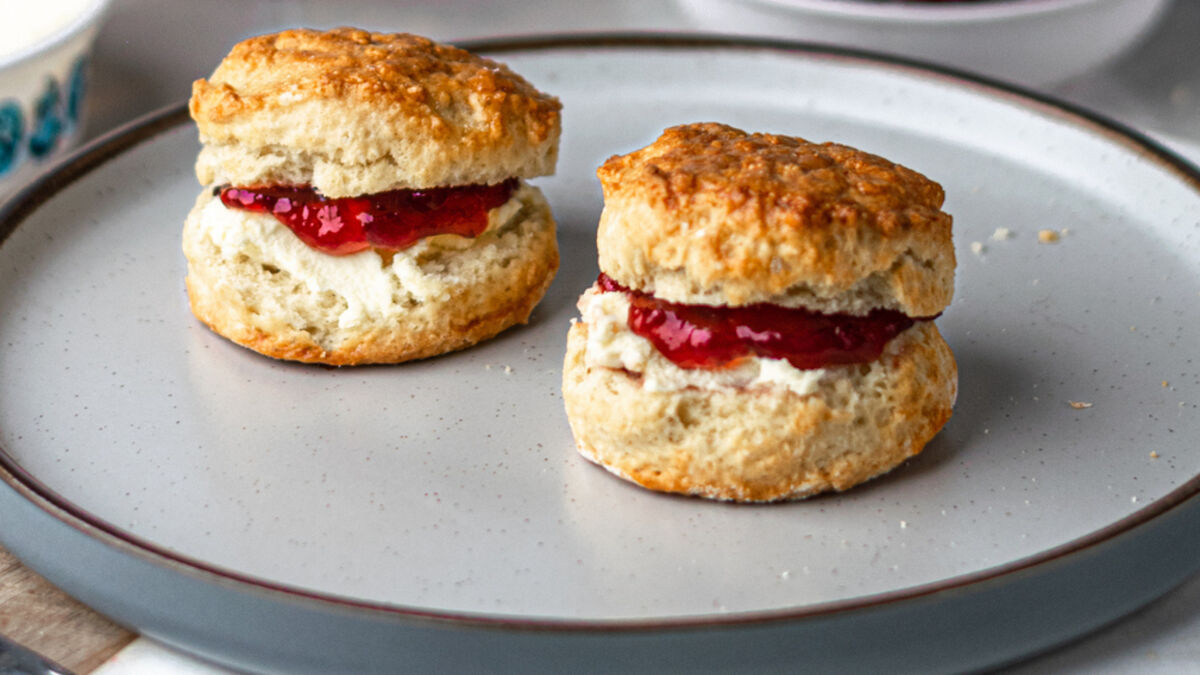Michelle Darmody: How to bake the classic Irish scone – and the mistakes to avoid
Starting the day with a warm scone covered in a generous layer of raspberry jam and a dollop of whipped cream is a real St Patrick’s weekend treat.
Scones are a quintessentially Irish recipe, while not the green of St Patrick’s Day they hold a special place in many Irish hearts.
Like other recipes that seem deceptively simple, it is quite easy to make a bad scone, one that feels more like a sliotar than a light and fluffy confection. However, a few hints and tips will help you make scones that people keep asking for again and again.
As with pastry, the key is to keep the butter for your scones cold and to handle the dough as little as possible. I simply pat it into shape rather than rolling it or kneading it. The other trick is the butter itself. It is not a huge portion of the mixture, but real butter does add the flavour and richness that you want.
It may be a bit more fiddly to use cream of tartar and bread soda in place of baking powder but I find it gives a lighter result. This is because the raising reaction happens quicker and adds air to the scones even though the baking time is quite short.
Homemade scones
Starting the day with a warm scone covered in a generous layer of raspberry jam and a dollop of whipped cream is a real St Patrick’s weekend treat.

Preparation Time
20 mins
Method
-
Line two flat baking trays with parchment and preheat your oven to 200ºC/gas mark 6.
-
Cut the cold butter into small cubes and place it back into the fridge as you prepare the other ingredients.
-
Sieve the flour, baking soda and cream of tartar together into a large bowl. Stir in the salt and sugar.
-
Crack the eggs into a mixing jug and whisk them lightly with a fork to combine the yolks and whites. Pour in enough buttermilk so you have 300mls in total. That is 300mls of the eggs and buttermilk combined.
-
Rub the cold butter into the dry ingredients until it looks like rough breadcrumbs. Stir in the egg mixture with a fork until the mixtures come together. Use your hands to bring the dough together fully.
-
Turn the dough onto a floured surface and pat it down to about an inch and a half thickness. Cut about fourteen scones with a round cutter. Place them onto the baking tray with a little distance between each one.
-
If you like you can brush the top of each scone with some beaten egg to give a glossy finish. Alternatively, you can sift a light dusting of flour on the top before baking.
-
Bake for about 20 minutes until the tops are golden.
-
Once cool enough to handle place them onto a wire rack to cool completely.
- If you find your scones are tough it is probably because the dough was over-handled. The less you handle the scone dough the lighter the scones will be. Pat rather than knead the dough before cutting. The mixture should be soft but not sticky.
- Don’t wiggle the cutter when you are cutting the dough, or else you will have lopsided scones. You want to firmly and swiftly press the cutter straight down and lift it straight out. The scone will probably come away with the cutter just hold the cutter over the baking tray, very near to the tray and tap the side of the cutter. It should gently plot onto the baking tray and keep its shape.
- It is best not to leave the dough sitting around but bake the scones soon after making them as the raising agent will start their reaction and will then not rise so well during baking.
- If you don’t have butter milk a squeeze of lemon juice to the milk sours it. The slightly acidic mix also gives an extra boost to the raising agents.
- I find I get tough scones with self-raising flour and using a mixture of plain flour with baking powder means they do not rise very well. I get a much better result with plain flour and a mixture of cream of tartar and bread soda. This essentially mimics baking powder which is a combination of bicarbonate of soda (bread soda) which is an alkaline and cream of tartar which is acidic. The reaction of the two creates carbon dioxide which causes the scones to rise. Combining the two leavening agents separately means they act quickly which helps to make light scones in the short baking time.
The most common recipe besides the plain scone is one containing dried fruit, usually sultanas but you can use raisins, dried cranberries, chopped dates or chopped apricots. Add about 85g of sultanas
before you bring the mixture together with your hands.
Add 1 level tsp of ground cinnamon when adding the flour. You can also add the zest of two oranges, as orange and cinnamon pair well together. Before baking I add a sprinkling of granulated sugar and dusting of cinnamon on top of each scone. This gives a nice sweet and crunchy finish.
You will need 1 tsp of vanilla essence and 1 hard pear, cored, peeled and cut into small cubes. Lightly mix vanilla into the milk and egg while it is in the jug, before it is added to the dough. Then gently stir the chopped pear into the dough before turning the mixture on to your floured surface.
